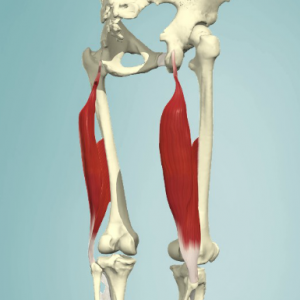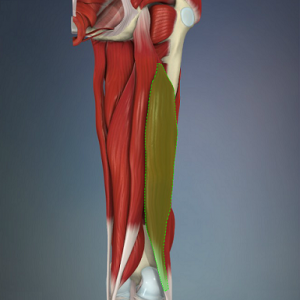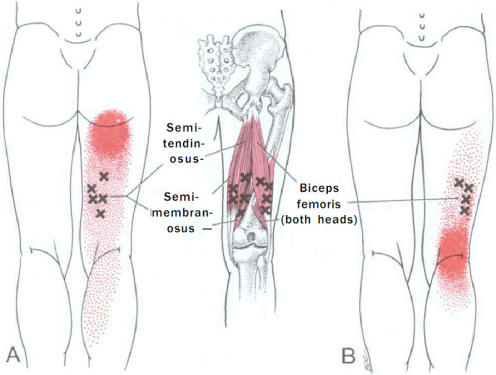Biceps Femoris
Original Editor - Evan Thomas
Top Contributors - Sai Kripa, Evan Thomas, Kim Jackson, Joao Costa, Ahmed M Diab, 127.0.0.1, George Prudden and WikiSysop
Description[edit | edit source]
Biceps femoris is a muscle of the posterior compartment of the thigh, and lies in the posterolateral aspect. It arises proximally by two 'heads', termed the 'long head' (superficial) and the 'short head' (deep). It is part of the hamstrings.[1]
| [2] | [1] |
|---|
Anatomy[edit | edit source]
Origin[edit | edit source]
- Long head: ischial tuberosity[3]
- Short head: linea aspera and lateral supracondylar line of the femur[3]
Insertion[edit | edit source]
- Lateral aspect of fibular head[3]
Nerve Supply[edit | edit source]
- Long head: tibial division of the sciatic nerve (L5-S2)[3]
- Short head: common peroneal division of the sciatic nerve[3]
Blood Supply[edit | edit source]
- Perforating branches of profunda femoris, inferior gluteal, and medial circumflex femoral arteries[3]
Function[edit | edit source]
Actions[edit | edit source]
- Long head: flexes the knee, extends hip, laterally rotates lower leg when knee slightly flexed, assists in lateral rotation of the thigh when hip extended[1][3]
- Short head: flexes the knee, laterally rotates lower leg when knee slightly flexed[1][3]
Functional contributions[edit | edit source]
- Through a reversed origin insertion action, the long head gives posterior stability to the pelvis[4]
- Both heads provide rotary stability by preventing forward dislocation of the tibia on the femur during flexion[4]
- Its contributions to the arcuate ligament complex at the posterolateral corner of the knee also provides varus and rotatory stability to the knee[4]
Techniques[edit | edit source]
Palpation[5][edit | edit source]
- Palpate the hamstrings laterally to find the biceps femoris muscle belly
- Follow it down towards the lateral side of the knee to find its long, prominent tendon ending at the head of the fibula
Length Tension Testing / Stretching[6][edit | edit source]
- With one hand, palpate the patient's ASIS and iliac crest with your thumb and index finger
- With the other hand, support the patient's leg just above the ankle
- Raise the patient's leg into hip flexion keeping the knee extended, and add internal rotation of the tibia to bias the biceps femoris
- Flexibility of the biceps femoris is exhausted when the innominate starts to rotate posteriorly
Trigger Point Referral Pattern[edit | edit source]
- Pain referred from TrPs in the lower half of the biceps femoris (long or short head) focuses on the back of the knee and may extend up the posterolateral area of the thigh as far as the crease of the buttock.[7]
References[edit | edit source]
- ↑ 1.0 1.1 1.2 1.3 http://www.anatomy.tv/interactivehip
- ↑ http://www.primalonlinelearning.com/cedaandp/muscular_system/muscles_of_the_lower_limb.aspx#bicepsfemoris
- ↑ 3.0 3.1 3.2 3.3 3.4 3.5 3.6 3.7 Netter FH (2014). Atlas of Human Anatomy (6th ed). Philadelphia, PA: Saunders-Elsevier.
- ↑ 4.0 4.1 4.2 http://www.wheelessonline.com/ortho/biceps_femoris
- ↑ Biel A (2005). Trail Guide to the Body (2nd ed). Boulder, CO: Books of Discovery.
- ↑ Sanzo P, MacHutchon M (2015). Length Tension Testing Book 1, Lower Quadrant: A Workbook of Manual Therapy Techniques (2nd ed). Canada: Brush Education.
- ↑ Travell JG, Simons DG, Simons LS (1998). Travell and Simons' Myofascial Pain and Dysfunction: The Trigger Point Manual, Volume 1: The Lower Extremities (2nd ed). Baltimore, MD: Williams & Wilkins.









